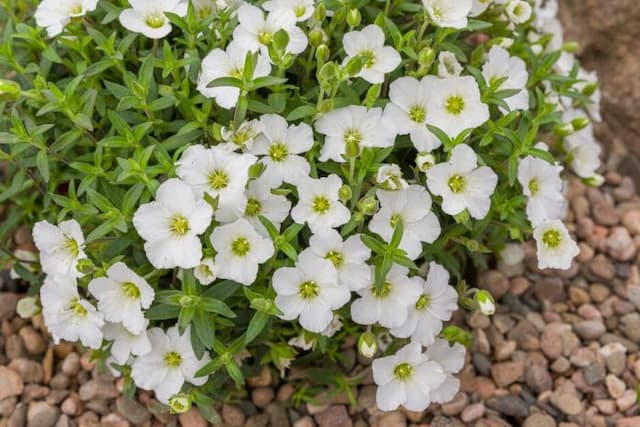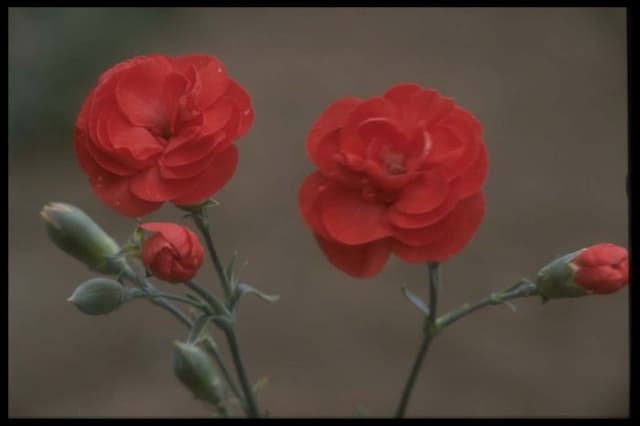Alpine Pink Dianthus alpinus 'Joan's Blood' (p)

ABOUT
Joan's Blood is a striking variety of the Dianthus family, showcasing a lush, mounding growth habit typical of its kind. The foliage is slender and bluish-green, forming a dense, tufted mat that serves as a backdrop to its most prominent feature—the flowers. The blooms are vivacious in color, a deep crimson that lives up to the 'blood' in its name, radiating an intensity that catches the eye. Each flower is composed of five petals with intricately fringed edges, creating a delicate, lacy appearance that contrasts with the bold coloration. These petals occasionally bear lighter or darker speckles and a subtle sheen, giving them an additional layer of visual interest. The blossoms, held singly or in small clusters, rise just above the foliage on thin stems, creating a floating effect that further accentuates their allure. This Dianthus variety exudes a spicy, clove-like fragrance, which is especially pronounced in the early morning or evening, adding a sensory delight to its visual charm. Overall, Joan's Blood conjures an image of elegant yet intense beauty, capable of injecting vibrant color and texture into the landscape.
About this plant
 Names
NamesFamily
Caryophyllaceae
Synonyms
Alpine Pink, Joan's Blood Dianthus
Common names
Dianthus alpinus.
 Toxicity
ToxicityTo humans
Alpine pink, the common name for Dianthus alpinus 'Joan's Blood', is not typically known for being toxic to humans. There is little to no information suggesting that alpine pink poses a significant toxic risk upon ingestion. However, as with any plant, individual allergies or sensitivities can occur, and it is generally not advisable to consume ornamental plants.
To pets
Alpine pink is not commonly listed as a toxic plant to pets. While it is always best to prevent pets from ingesting plants unnecessarily, there is no well-documented toxicity associated with Dianthus alpinus 'Joan's Blood' for domestic animals. However, pet owners should always monitor for any signs of distress after ingestion of any plant material, as individual reactions can vary.
 Characteristics
CharacteristicsLife cycle
Perennials
Foliage type
Evergreen
Color of leaves
Blue-green
Flower color
Red
Height
6 inches (15 cm)
Spread
6 inches (15 cm)
Plant type
Herb
Hardiness zones
5
Native area
Alps
Benefits
 General Benefits
General Benefits- Decorative Appeal: Dianthus alpinus 'Joan's Blood' is known for its bright red flowers that add vibrant color and aesthetic appeal to gardens and landscapes.
- Low Maintenance: This plant is relatively easy to care for, requiring minimal attention once established, making it a good choice for gardeners of all skill levels.
- Drought Tolerance: Once established, it is quite drought-tolerant, making it suitable for xeriscaping and water-wise gardens.
- Cold Hardy: The plant is hardy in cold temperatures, which makes it suitable for gardens in cooler climates.
- Attracts Pollinators: The flowers attract bees and butterflies, supporting local ecosystems and pollination in the garden.
- Long Blooming Season: It offers a long blooming season from late spring to early summer, providing extended color and interest in the garden.
- Compact Growth: Its compact and low-growing habit makes it ideal for use in rock gardens, borders, and as ground cover.
- Evergreen Foliage: The plant often retains its foliage throughout the year, contributing to the garden's winter interest.
- Edging and Borders: Its size and form make it an excellent choice for edging and creating defined borders in garden beds.
- Works in Containers: It can thrive in containers, allowing for flexibility in garden design and for those with limited space.
- Deer Resistance: Although no plant is deer-proof, Dianthus alpinus 'Joan's Blood' is known to have some resistance to deer, which can be beneficial in areas where deer browsing is a problem.
 Medical Properties
Medical PropertiesThis plant is not used for medical purposes.
 Air-purifying Qualities
Air-purifying QualitiesThis plant is not specifically known for air purifying qualities.
 Other Uses
Other Uses- Dianthus alpinus, also known as Alpine Pink, can be utilized in making perfumes because of its sweet fragrance.
- The flower's vibrant colors can be used in dyes for fabrics or art projects, although this is not a common practice.
- Alpine Pink petals are sometimes used in potpourri blends to provide color and a mild scent.
- This plant can be used in educational settings as a study organism for genetics, given its variety of color morphs.
- Alpine Pink may serve as an ornament in ice sculptures or frozen decorations for events due to its resilience in cold temperatures.
- The flowers can be crystallized and used as edible decorations for desserts and other culinary presentations.
- Alpine Pink can be a model subject in photography, providing a natural contrasting element in landscapes or macro shots.
- The plant is suitable for miniature gardens or fairy gardens due to its compact growth habit and attractive appearance.
- In floristry, Alpine Pink is occasionally used in creating boutonnieres or corsages for special occasions.
- It can be implemented in landscape design courses as an example of alpine flora and their specific needs and characteristics.
Interesting Facts
 Feng Shui
Feng ShuiThe Alpine Pink is not used in Feng Shui practice.
 Zodiac Sign Compitability
Zodiac Sign CompitabilityThe Alpine Pink is not used in astrology practice.
 Plant Symbolism
Plant Symbolism- Love: Dianthus is often associated with love due to its historical use in festivals and decor celebrating love and affection.
- Admiration: The bold color of 'Joan's Blood' can symbolize deep admiration and high esteem, making it a suitable gift for someone you deeply respect.
- Boldness and Bravery: The vibrant and intense color of 'Joan's Blood' can be symbolic of boldness and bravery, perhaps paying homage to Joan of Arc, who the plant may be named after.
- Devotion and Commitment: Dianthus flowers, in general, can represent a deep sense of devotion and an unbreakable bond between individuals.
- Divine Love: Due to the flower's historical connection to deities in ancient Greece, it can also symbolize divine love or blessings.
 Water
WaterAlpine Pinks prefer to be watered deeply but infrequently as their root systems are prone to rot with too much moisture. They thrive in well-drained soil, so allowing the soil to dry out somewhat between waterings is important. Typically, you should water these plants once every week or two, depending on the weather conditions and the soil's moisture level, with about 1-2 gallons of water. During hot or dry spells, more frequent watering may be necessary, while in cooler, wetter conditions, less frequent watering is required. It's crucial not to let the plant sit in waterlogged soil, so ensure proper drainage.
 Light
LightAlpine Pinks need full sun to flourish, which means they require at least six hours of direct sunlight daily. The ideal spot would be in an area where they can bask in the morning sun, which is less intense, while still receiving ample light throughout the day. Too much shade can lead to leggy growth and a decrease in the number of blooms.
 Temperature
TemperatureAlpine Pinks are hardy alpine plants, and they can tolerate temperatures as low as 20°F. However, they perform best in temperatures ranging between 60°F and 70°F during the growing season. It's important to protect these plants from extreme heat above 85°F, as they can experience stress and potential damage.
 Pruning
PruningPrune Alpine Pinks to remove spent flowers and encourage a second bloom, as well as to maintain a compact growth habit and good plant health. Deadheading after the first bloom in late spring or early summer can promote further flowering. Pruning is best done just after the plant has finished its main flowering period.
 Cleaning
CleaningAs needed
 Soil
SoilAlpine Pinks prefer well-draining, loose soil with a slightly alkaline pH between 7.0 and 8.0. A mix of regular garden soil combined with sharp sand and fine gravel or perlite will enhance drainage. Adding some compost or well-rotted manure will provide necessary nutrients. It's vital to avoid waterlogged conditions to prevent root rot.
 Repotting
RepottingAlpine Pinks generally do not need frequent repotting and can thrive in the same pot for several years. They should be repotted every 2-3 years, or when you notice that the plant has outgrown its current pot, to refresh the soil and provide additional room for root growth.
 Humidity & Misting
Humidity & MistingAlpine Pinks prefer a drier climate and do not require high humidity levels. They are well-suited to the natural humidity found in most temperate climates. Consistently high humidity can promote fungal diseases, so ensuring good air circulation around the plants is important.
 Suitable locations
Suitable locationsIndoor
Ensure bright light, cool temps, and good air circulation.
Outdoor
Plant in full sun, well-draining soil, protect from harsh winds.
Hardiness zone
5-9 USDA
 Life cycle
Life cycleThe 'Joan's Blood' Alpine Pink, a cultivar of Dianthus alpinus, begins its life cycle when seeds germinate in the spring after experiencing cold stratification, which breaks seed dormancy. Seedlings emerge and establish a root system while developing into a rosette of foliage during their first growing season. In the following season, the plant produces flowering stems, displaying its characteristic deep red blossoms throughout late spring and summer, attracting pollinators. After pollination, the flowers develop into capsules containing seeds that, when mature, are dispersed by wind or gravity. The plant is a perennial, subsequently retreating into a period of dormancy during the winter months where above-ground growth dies back and it survives through its hardy root system. The cycle repeats each year with resumption of growth in the spring, as the plant continues to mature and may spread through self-seeding or vegetative propagation.
 Propogation
PropogationPropogation time
Spring-Early Summer
The Dianthus alpinus 'Joan's Blood', commonly known as the Alpine Pinks, can be propagated by taking softwood cuttings. This popular method of propagation for Alpine Pinks typically takes place during late spring or early summer, when the plant's growth is vigorous and the new stems are just beginning to mature. To propagate, locate a healthy non-flowering shoot and cut a piece about 3 to 5 inches long, slanting the cut just below a node. Strip away the lower leaves and dip the cut end into a rooting hormone to encourage root development. The cutting should then be planted in a well-draining soil mix, ensuring that the nodes where the leaves were removed are buried as these are where roots will form. The cutting needs to be kept in a warm environment with high humidity and indirect light until roots have formed, which generally takes several weeks. Once the cutting has rooted, it can be transplanted into the garden or a larger pot to continue growing.


![Pink [Tequila Sunrise]](/_next/image?url=https%3A%2F%2Fplants-admin.emdemapps.com%2Fimages%2Fplants%2F%2Fimages%2F604b5d995d06e.png&w=640&q=75)






